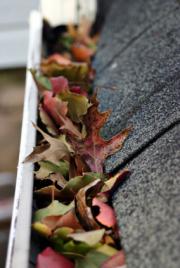Drafty Windows and Doors
Drafty windows and doors can increase heating bills, and no one wants that! Take the time to inspect both the interior and exterior of all windows and doors.

If you inspect the property on a windy day, it may make it easier to detect any air leaks.
- Make Sure the Windows Close Tightly
This seems like a no-brainer, until you get that cool draft followed by a quick shiver only to realize that you have an open window. Especially in older windows, it is not uncommon for the top portion of the window to creep down, leaving a slight gap for air to come in. You simply have to unlock the window and push the top portion of the window up and the bottom portion of the window down to make sure it is properly closed. You can then lock the window again.
- Check Weather Stripping
You will want to look around each frame for any obvious holes or deteriorating caulk. Look for any loose or damaged weather stripping. You will want to re-caulk any deteriorating caulk and replace any damaged weather stripping.
- Feel for Drafts
On the interior of the property, you can look for signs of light around the perimeter of the windows or doors. You can also physically feel for drafts. If you want to get fancy, you can even purchase an infrared thermometer, which you simply point at any spot and it will give you a temperature reading.
- Door Sweeps
You can consider adding door sweeps on the bottom of entrance doors. You can get temporary ones that you can slide onto the bottom of the door or more permanent ones that you can screw into the bottom of the doors.
- Single Pane Windows
If your home has older, single pane windows, you may consider wrapping them in plastic window wrap that you can purchase at stores like Home Depot or Lowes. This wrap will help to keep out drafts.
As a longer term investment, you may consider upgrading to double pane windows. This could help save you money not having to turn the heat up so high since heat will not be escaping. Shoring up these air leaks will help keep the property warm in the winter.
If you’re looking for a more comprehensive review – contact Home Inspection Professionals for a customized energy audit and see where you can save!

 Buried irrigation lines can freeze, leaving you with burst pipes and broken sprinkler heads. A few simple steps can save you some spring time Irrigation Irritation.
Buried irrigation lines can freeze, leaving you with burst pipes and broken sprinkler heads. A few simple steps can save you some spring time Irrigation Irritation. Each year, Michigan homeowners and businesses are hit with the harsh reality of winter, dealing with everything from snow covered roads and pot holes to slippery driveways and the dreaded NO SCHOOL Snow Days. You can’t change the weather, but we can minimize the toll it may take by implementing a few simple safeguards. Heating and plumbing maintenance and the right insurance coverage, can help minimize any financial burdens that may follow seasonal storm damage.
Each year, Michigan homeowners and businesses are hit with the harsh reality of winter, dealing with everything from snow covered roads and pot holes to slippery driveways and the dreaded NO SCHOOL Snow Days. You can’t change the weather, but we can minimize the toll it may take by implementing a few simple safeguards. Heating and plumbing maintenance and the right insurance coverage, can help minimize any financial burdens that may follow seasonal storm damage. Lubricate locks and hinges: Creaky hinges and sticking locks can spook you at exactly the wrong moment, so make the rounds with a can of WD-40. It’ll clean and lubricate metal mechanisms in one shot.
Lubricate locks and hinges: Creaky hinges and sticking locks can spook you at exactly the wrong moment, so make the rounds with a can of WD-40. It’ll clean and lubricate metal mechanisms in one shot. Quiet kitchen cabinets: Before the Fall is over, your kitchen will soon be bustling with holiday dinners, baking projects, and house guests, so don’t let little annoyances get in the way of big plans. Clean and lubricate drawers and hinges on kitchen cabinets, and replace any catches that no longer catch.
Quiet kitchen cabinets: Before the Fall is over, your kitchen will soon be bustling with holiday dinners, baking projects, and house guests, so don’t let little annoyances get in the way of big plans. Clean and lubricate drawers and hinges on kitchen cabinets, and replace any catches that no longer catch.